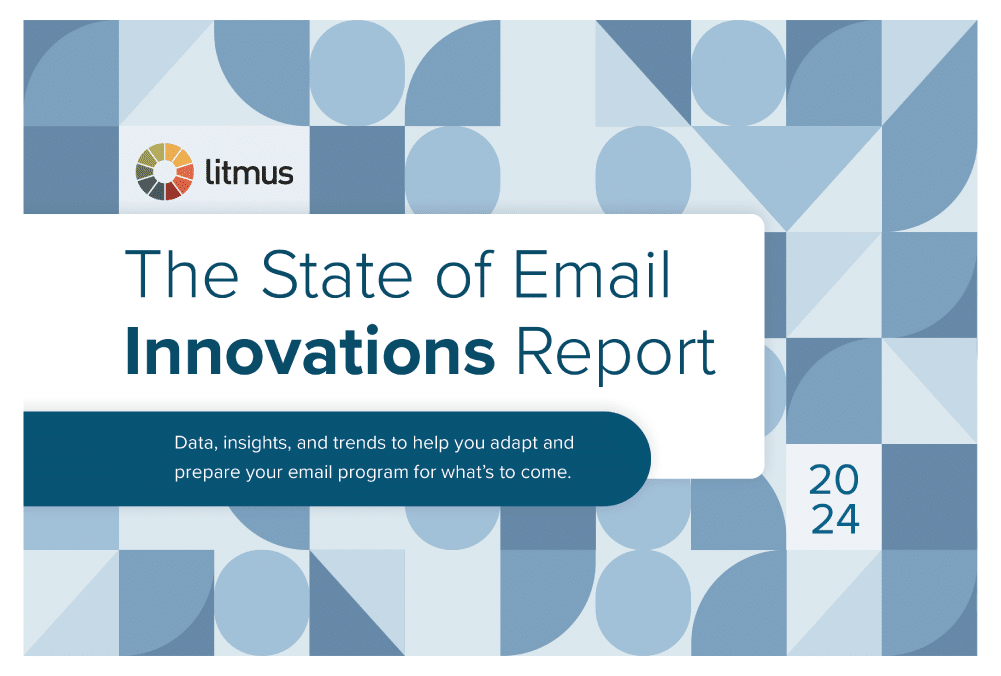Key takeaways ✨
|
We recently had a State of Email crossover event, or “State of Email-ception” if you will.
Joining Validity’s State of Email Live webinar session, we dove into the Litmus State of Email in 2025 report alongside a fantastic roundtable of email experts who are just as passionate (and nerdy) about this topic as we are.
Our panel of email geeks was hosted by Validity’s VP of Customer Engagement, Guy Hanson, and included Beth O’Malley of astral, Dave Charest of Constant Contact, Lauren Gannon of Zeta Global, and Leah Miranda of Zapier.
While we highly recommend watching the full recording on-demand, if you’re short on time, here are a few of the key takeaways from the conversation.
Table of contents
- Email marketing in 2025 is…challenging
- Email marketing has a high ROI, but it’s tough to prove
- Some email marketing KPIs are more valuable than others
- Email accessibility is being wrongfully de-prioritized
- Interactive elements can enhance your emails (when used correctly)
- AI’s role in email marketing’s future will continue to expand
Power up your email strategy
Gain expert insights and industry benchmarks from the latest State of Email Report. Elevate your email game.
Email marketing in 2025 is… challenging
During the webinar, Hanson asked each panelist to reflect on the challenges and roadblocks highlighted by respondents in the Litmus report. He also invited them to share their initial tips for overcoming these obstacles.
Charest addressed the 22% of respondents who reported struggling to measure and/or prove ROI. He explained that siloed departments often make it harder to tell a cohesive revenue story through email metrics. His advice? Break down those barriers and foster collaboration across teams.
Miranda focused on the challenges surrounding data quality. Her solution? Aim for incremental progress instead of striving for perfection, and back your efforts with thorough testing before hitting send.
Gannon resonated with the 16% of respondents who cited difficulties with personalization at scale. She encouraged brands to start small and leverage responsive templates. “You don’t have to personalize every pixel,” she emphasized. Instead, focus on creating dynamic, engaging experiences.
O’Malley spoke to the 20% of respondents grappling with low email engagement rates. She suggested defining clear engagement success criteria tailored to different customer and subscriber personas to better connect with your audience.
Email marketing has a high ROI, but it’s tough to prove
Our research shows that email marketing offers an impressive ROI, with marketers reporting returns between 10:1 and 36:1 from their email programs. However, 21% of respondents admitted being unsure of their current ROI—a stat worth addressing.
Charest explained that email is such a high ROI channel because it’s permission-based and relatively low-cost to send. However, he acknowledged the challenge marketers face when trying to measure success: not all metrics fit neatly into a single dashboard.
So, what can email marketers do when traditional metrics like opens and click-through rates (CTRs) fall short? Miranda encouraged participants to take a step back and define the role email plays in their broader marketing strategy. Whether it’s driving brand awareness, customer acquisition, retention, or engagement, aligning email goals with overarching business objectives is key.
From there, marketers can move beyond the “last touch” approach to metrics and educate leadership on the value of impact metrics—those that measure email’s contribution to long-term success.
O’Malley agreed and expanded on the importance of impact metrics.
Before diving into impact metrics, Gannon shared actionable tips for boosting ROI by analyzing automations. She emphasized the importance of reaching customers at key moments of intent with email sequences like:
- Cart abandonment
- Inventory restock
- Price drops
Go beyond opens and clicks
Brands that use Litmus Email Analytics see a 43% higher ROI than those that don’t. See what you’re missing. Learn more.
Some email marketing KPIs are more valuable than others
While over half of respondents in our research rely on traditional engagement metrics like opens and clicks to assess the success of their email programs, O’Malley made a compelling case for moving beyond open rates—a stance she described as her “hill to die on.”
Instead, she shared a set of impact metrics that provide a deeper, more meaningful picture of email performance:
- Cost per subscriber
- Average time to first action (how long it takes for a subscriber to complete your desired action)
- Subscriber-to-customer rate
- Web traffic (how much traffic your email program drives to your site)
- Email-assisted conversions (how many conversions were influenced by an email touchpoint)
The rest of the panelists echoed O’Malley’s advice, urging marketers to shift their focus from revenue in isolation to a more holistic view of performance across the entire customer lifecycle. By analyzing metrics that highlight email’s broader impact, marketers can tell a stronger and more strategic story about their programs.
Measure the effectiveness of your email program
Dig deeper into email metrics you should actually care about using Validity’s Guide to Email Marketing Metrics.

Email accessibility is being wrongfully de-prioritized
Our research uncovered a troubling statistic: only 47% of companies incorporate even basic accessibility measures, like alt text, in their emails. But why is accessibility overlooked? Is it simply laziness?
Our panelists didn’t think so. O’Malley pointed out that many email marketers face intense pressure to deliver commercial value and get campaigns out the door quickly. This urgency often leads to accessibility being unintentionally de-prioritized, despite its importance.
Both Miranda and Gannon advocated for a practical, incremental approach to accessibility. They recommended starting with easy wins—such as adding alt text and using semantic code—before progressing to more advanced measures, like building fully accessible email templates for future use.
Accessibility made simple
Creating accessible emails is no longer optional—it’s required. Learn about accessibility’s impact on brands from two industry experts.
Interactive elements can enhance your emails (when used correctly)
Interactive elements are a powerful way to stand out in crowded inboxes, and it’s no surprise that 97% of marketers use at least one in their email campaigns. During the webinar, each panelist shared their favorite interactive elements to include in emails:
- Product carousels to show more content in a small space—Gannon
- Dynamic content/product recommendations to provide more personalization for each customer—Charest
- Countdown timers to create a sense of urgency—Miranda
While interactive features can significantly enhance engagement, O’Malley offered a word of caution: only use them if you have good attribution, not just for a few cheap clicks.
AI’s role in email marketing’s future will continue to expand
One of the most groundbreaking statistics from the report was the 340% increase in marketers using generative AI to create images between 2024 and 2025. This dramatic rise signals AI’s growing role in shaping the future of email marketing.
Our panel of experts agreed that while AI will undoubtedly continue to play a key role in email marketing, success will depend on using it as a tool rather than an outcome. Expanding beyond content generation and approaching AI strategically will be crucial in unlocking its full potential.
Miranda, O’Malley, and Charest emphasized the opportunity to integrate AI into CRMs to enhance targeting decisions by leveraging customer intent data. This application could help marketers deliver more personalized and impactful campaigns.
We were incredibly grateful to bring together Litmus, Validity, and this wonderful panel of email experts for this discussion. It was also amazing to see the chat during the webinar light up with engaged email geeks sharing their thoughts.
Feeling a little FOMO? Don’t worry! You can watch the entire webinar here.
Learn from the best
Your favorite brands use Litmus to deliver flawless email experiences. Discover the ROI your emails can achieve with Litmus.
Matt is a Content Marketer at Validity




